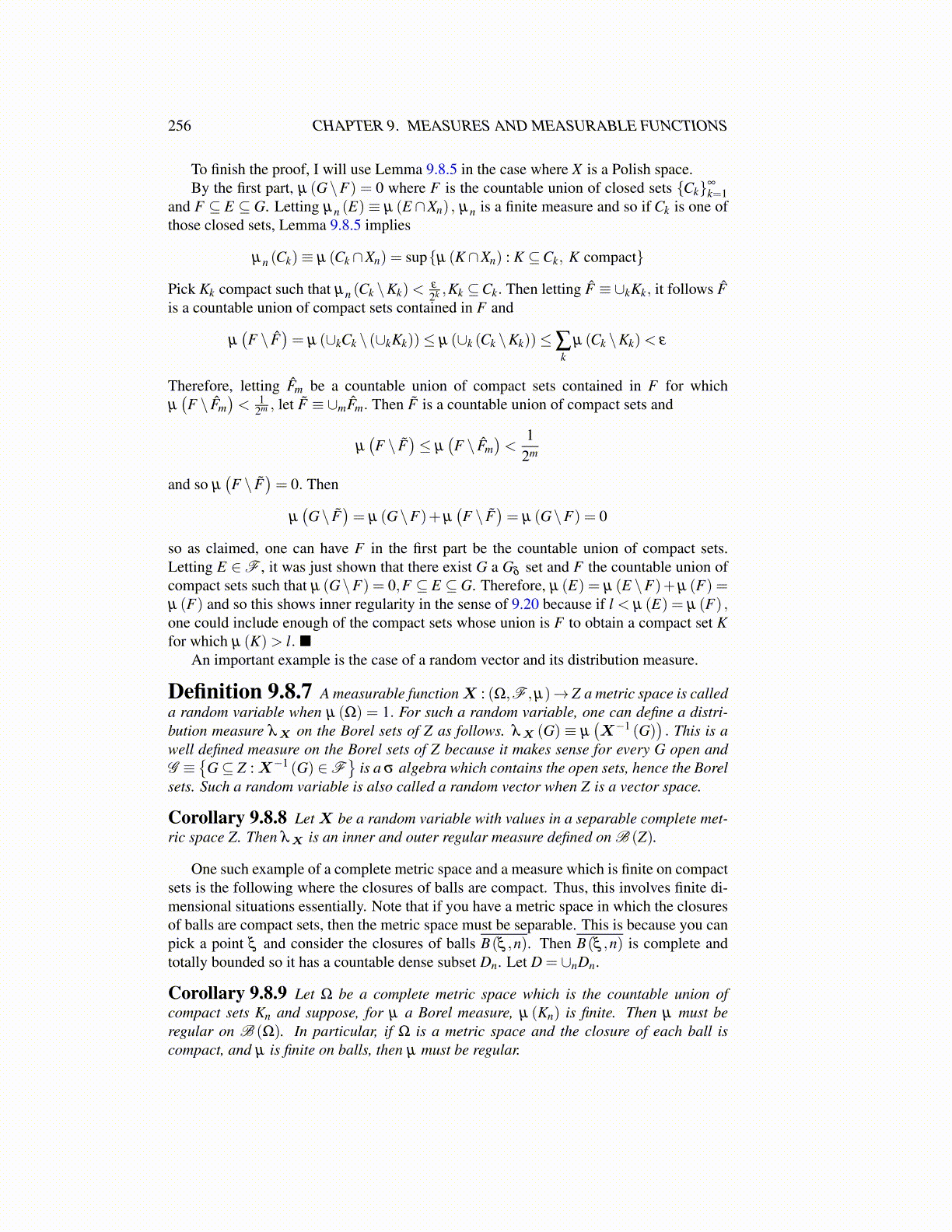
256 CHAPTER 9. MEASURES AND MEASURABLE FUNCTIONS
To finish the proof, I will use Lemma 9.8.5 in the case where X is a Polish space.By the first part, µ (G\F) = 0 where F is the countable union of closed sets {Ck}∞
k=1and F ⊆ E ⊆ G. Letting µn (E)≡ µ (E ∩Xn) , µn is a finite measure and so if Ck is one ofthose closed sets, Lemma 9.8.5 implies
µn (Ck)≡ µ (Ck ∩Xn) = sup{µ (K∩Xn) : K ⊆Ck, K compact}
Pick Kk compact such that µn (Ck \Kk)<ε
2k ,Kk ⊆Ck. Then letting F̂ ≡∪kKk, it follows F̂is a countable union of compact sets contained in F and
µ(F \ F̂
)= µ (∪kCk \ (∪kKk))≤ µ (∪k (Ck \Kk))≤∑
kµ (Ck \Kk)< ε
Therefore, letting F̂m be a countable union of compact sets contained in F for whichµ(F \ F̂m
)< 1
2m , let F̃ ≡ ∪mF̂m. Then F̃ is a countable union of compact sets and
µ(F \ F̃
)≤ µ
(F \ F̂m
)<
12m
and so µ(F \ F̃
)= 0. Then
µ(G\ F̃
)= µ (G\F)+µ
(F \ F̃
)= µ (G\F) = 0
so as claimed, one can have F in the first part be the countable union of compact sets.Letting E ∈F , it was just shown that there exist G a Gδ set and F the countable union ofcompact sets such that µ (G\F) = 0,F ⊆ E ⊆ G. Therefore, µ (E) = µ (E \F)+µ (F) =µ (F) and so this shows inner regularity in the sense of 9.20 because if l < µ (E) = µ (F) ,one could include enough of the compact sets whose union is F to obtain a compact set Kfor which µ (K)> l. ■
An important example is the case of a random vector and its distribution measure.
Definition 9.8.7 A measurable functionX : (Ω,F ,µ)→ Z a metric space is calleda random variable when µ (Ω) = 1. For such a random variable, one can define a distri-bution measure λX on the Borel sets of Z as follows. λX (G) ≡ µ
(X−1 (G)
). This is a
well defined measure on the Borel sets of Z because it makes sense for every G open andG ≡
{G⊆ Z :X−1 (G) ∈F
}is a σ algebra which contains the open sets, hence the Borel
sets. Such a random variable is also called a random vector when Z is a vector space.
Corollary 9.8.8 LetX be a random variable with values in a separable complete met-ric space Z. Then λX is an inner and outer regular measure defined on B (Z).
One such example of a complete metric space and a measure which is finite on compactsets is the following where the closures of balls are compact. Thus, this involves finite di-mensional situations essentially. Note that if you have a metric space in which the closuresof balls are compact sets, then the metric space must be separable. This is because you canpick a point ξ and consider the closures of balls B(ξ ,n). Then B(ξ ,n) is complete andtotally bounded so it has a countable dense subset Dn. Let D = ∪nDn.
Corollary 9.8.9 Let Ω be a complete metric space which is the countable union ofcompact sets Kn and suppose, for µ a Borel measure, µ (Kn) is finite. Then µ must beregular on B (Ω). In particular, if Ω is a metric space and the closure of each ball iscompact, and µ is finite on balls, then µ must be regular.